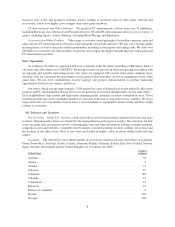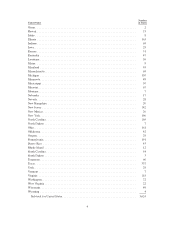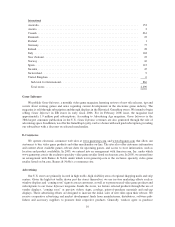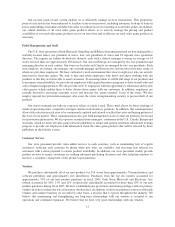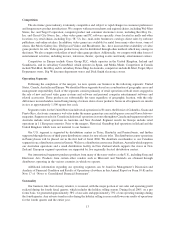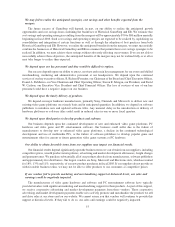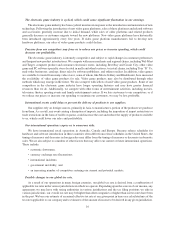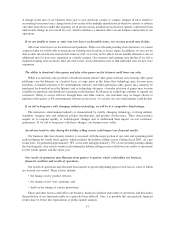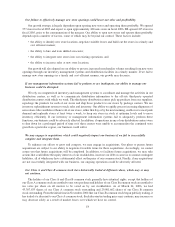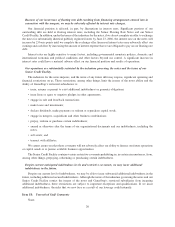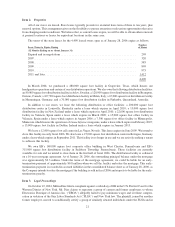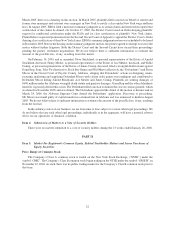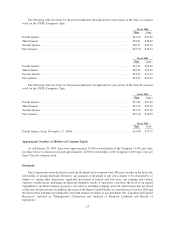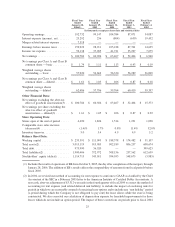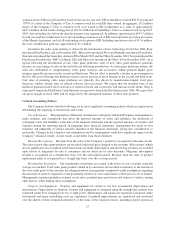GameStop 2005 Annual Report Download - page 27
Download and view the complete annual report
Please find page 27 of the 2005 GameStop annual report below. You can navigate through the pages in the report by either clicking on the pages listed below, or by using the keyword search tool below to find specific information within the annual report.Our failure to effectively manage new store openings could lower our sales and profitability.
Our growth strategy is largely dependent upon opening new stores and operating them profitably. We opened
377 stores in fiscal 2005 and expect to open approximately 400 new stores in fiscal 2006. EB opened 415 stores in
fiscal 2005, prior to the consummation of the mergers. Our ability to open new stores and operate them profitably
depends upon a number of factors, some of which may be beyond our control. These factors include:
• the ability to identify new store locations, negotiate suitable leases and build out the stores in a timely and
cost efficient manner;
• the ability to hire and train skilled associates;
• the ability to integrate new stores into our existing operations; and
• the ability to increase sales at new store locations.
Our growth will also depend on our ability to process increased merchandise volume resulting from new store
openings through our inventory management systems and distribution facilities in a timely manner. If we fail to
manage new store openings in a timely and cost efficient manner, our growth may decrease.
If our management information systems fail to perform or are inadequate, our ability to manage our
business could be disrupted.
We rely on computerized inventory and management systems to coordinate and manage the activities in our
distribution centers, as well as to communicate distribution information to the off-site third-party operated
distribution centers with which we work. The third-party distribution centers pick up products from our suppliers,
repackage the products for each of our stores and ship those products to our stores by package carriers. We use
inventory replenishment systems to track sales and inventory. Our ability to rapidly process incoming shipments of
new release titles and deliver them to all of our stores, either that day or by the next morning, enables us to meet peak
demand and replenish stores at least twice a week, to keep our stores in stock at optimum levels and to move
inventory efficiently. If our inventory or management information systems fail to adequately perform these
functions, our business could be adversely affected. In addition, if operations in any of our distribution centers were
to shut down for a prolonged period of time or if these centers were unable to accommodate the continued store
growth in a particular region, our business could suffer.
We may engage in acquisitions which could negatively impact our business if we fail to successfully
complete and integrate them.
To enhance our efforts to grow and compete, we may engage in acquisitions. Our plans to pursue future
acquisitions are subject to our ability to negotiate favorable terms for these acquisitions. Accordingly, we cannot
assure you that future acquisitions will be completed. In addition, to facilitate future acquisitions, we may take
actions that could dilute the equity interests of our stockholders, increase our debt or cause us to assume contingent
liabilities, all of which may have a detrimental effect on the price of our common stock. Finally, if any acquisitions
are not successfully integrated with our business, our ongoing operations could be adversely affected.
Our Class A and Class B common stock have historically traded at different values, which may or may
not continue.
The holders of our Class A and Class B common stock generally have identical rights, except that holders of
our Class A common stock are entitled to one vote per share and holders of our Class B common stock are entitled to
ten votes per share on all matters to be voted on by our stockholders. As of March 24, 2006, we had
43,307,633 shares of our Class A common stock outstanding and 29,901,662 shares of our Class B common
stock outstanding. From the initial time in November 2004 that our Class B common stock began publicly trading, it
has traded at a discount to our Class A common stock. Such discount in trading price may continue, may increase or
may decrease solely as a result of market forces over which we have no control.
18


